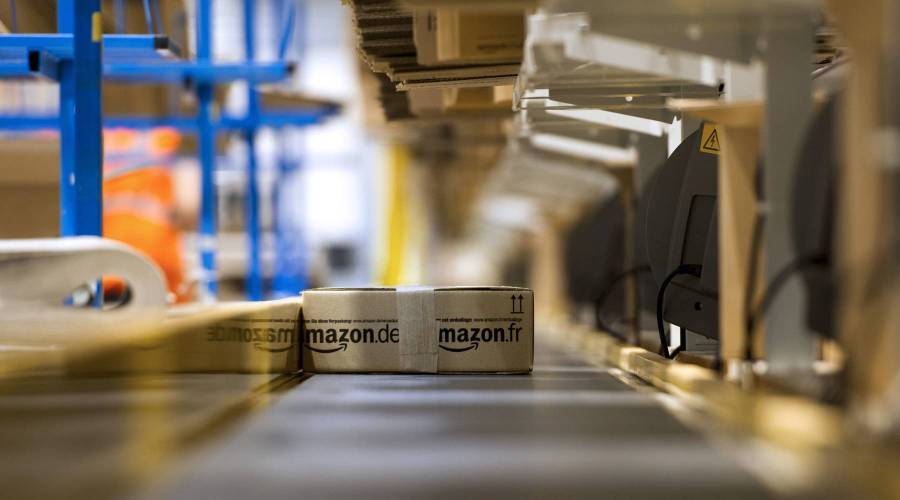Online retail has all the advantages over brick-and-mortar stores, right?

Amazon has built its empire, in large part, on one transformative promise: Your stuff shows up in two days. Nearly a third of the U.S. population has signed up for Amazon Prime at $120 per year. This near-instant gratification was forecast to be a very large nail in the coffin for brick-and-mortar retail. But all those physical spaces still have some advantages over the online giant. Mainly it’s that they’re already near people. Amazon is expanding its delivery options with lockers, bundled deliveries on a set day and a new partnership with Kohl’s, an actual store, to handle Amazon returns.
Marketplace’s Jack Stewart talked with Chris Hess, director of supply chain solutions for Kenco Group. Hess used to design supply chains for Amazon, and he says the company doesn’t simply experiment wildly. The following is an edited transcript of their conversation.
Chris Hess: Amazon does lots of data analytics before they jump into anything. The ideas, a lot of them, come from their customer service. They listen to the [phone] lines and do data analytics on what customers are saying. Then it goes into: Can we make the supply chain do what the customer is asking for? Does it cost us more? Does it cost us less than what our current state is? And if it costs us a little bit more, what are the potential other benefits, like convenience, environment and those types of things? When they have enough to say it makes sense, they’re going to go out and pilot it to see if it works and then tweak, adjust and ramp up faster if it looks like it’s got promise.
Jack Stewart: It definitely is convenient to get the things that you want in as little time as possible, a couple of days to have things delivered to your house. But that’s got to be expensive. Amazon spends billions of dollars on shipping every year. Are some of these moves actually about saving money?
Hess: I think Amazon looks at it from a little bit broader picture. All the brick-and-mortars have stores and clerks and distribution networks behind them to get stuff to that shelf for you to drive to it and buy. And so they look at it as, “Hey, we have all this money that we don’t have invested in bricks-and-mortar and stock clerks and those types of folks to do those jobs, so we can use that money to pay for transportation costs directly to your home.” Some of these [options] — bundling things and lockers — are just ways to reduce costs for folks that don’t really need it in two days but, because they have Prime, hit the button.
Stewart: What sort of pressure does it put on competitors? Amazon has made this sort of two-day delivery the standard expectation now.
Hess: Absolutely. I think you see different things going on, especially in the brick-and-mortar area with the likes of Walmart. Now with order online, swing by on your way home to pick up at the store already picked and packed, and somebody’s going to come out and basically place it in your trunk for you. Other companies that are brick and mortar are moving inventory out of their back rooms and creating fulfillment operations in their back rooms and paying some of their employees on the way home to deliver packages for them to try and reduce delivery costs, because they’re already within 3 to 5 miles of most of their customers from that store location.
Related links: more insight from Jack Stewart
The idea of stores using their staff to do deliveries on their own way home sounds like an intriguing way of getting stuff to people without having to build a whole new network. But Retail Dive has an article that says Walmart had to go back to the drawing board after its first attempt to do just that. A report from Reuters says the biggest challenge was getting associates to volunteer, despite extra pay, because they were worried about using their personal vehicles. Walmart is reportedly trying again with a revamped, but more limited, plan.
And we can’t mention the future of deliveries without talking about drones. After all, the hype all started when Amazon’s Jeff Bezos promoted the idea in a “60 Minutes” interview in 2013. This week Alphabet, Google’s parent company, got the go-ahead to start delivering goods in rural Virginia. UPS is flying blood samples from hospitals to labs via drones in a pilot in North Carolina. Performing medical deliveries sounds a lot higher stakes than dropping off paper towels and pizza, but it’s also probably easier to sell a project to local authorities, and residents, if you can call it “potentially life saving.”
The future of this podcast starts with you.
Every day, the “Marketplace Tech” team demystifies the digital economy with stories that explore more than just Big Tech. We’re committed to covering topics that matter to you and the world around us, diving deep into how technology intersects with climate change, inequity, and disinformation.
As part of a nonprofit newsroom, we’re counting on listeners like you to keep this public service paywall-free and available to all.
Support “Marketplace Tech” in any amount today and become a partner in our mission.


















